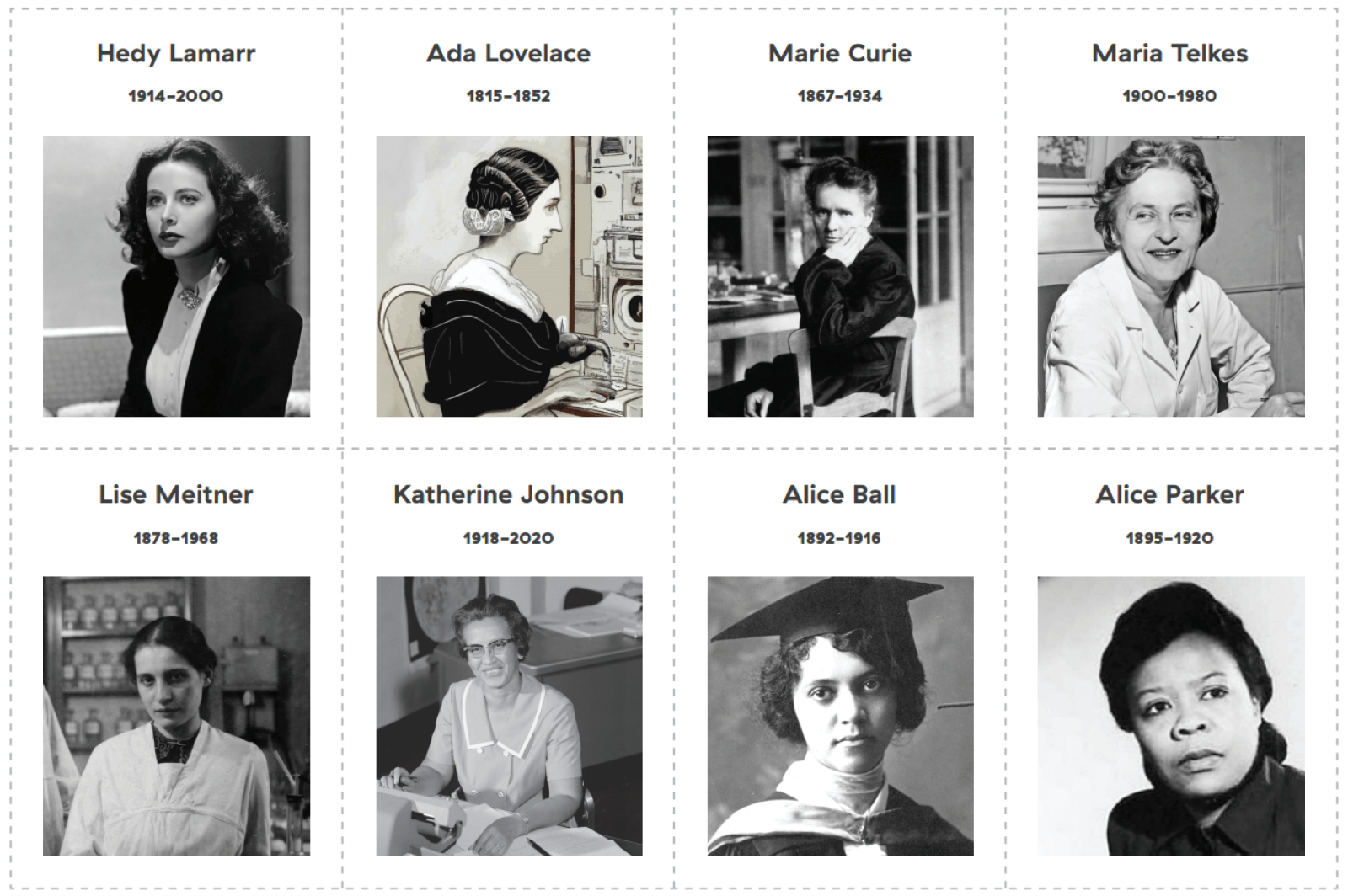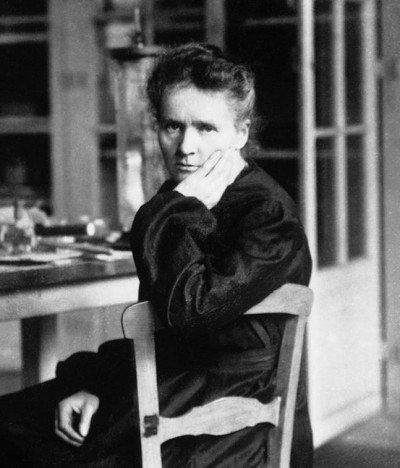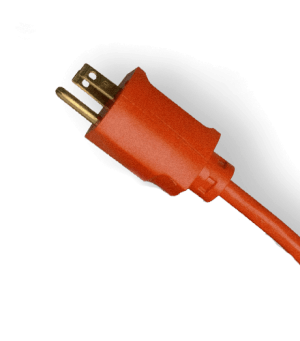Women in history: who do you know?
Discover and celebrate amazing women who have contributed to science, technology, engineering and mathematics throughout history.

Overview
In this activity students learn about women in history who made contributions to science but often were not credited for their discoveries. Students then critically think about how they would feel if their accomplishments were credited to another, and why. They finish the activity by playing a memory matching game to learn more about historical women in STEM.
Part of the Women in STEM, then and now unit.
Instructions
What you'll need
- Computer and TV or projector
- Women in STEM history slideshow
- Women in STEM memory cards: print and cut out one set per group of 3-5 students
- Video: Women in science who changed the world (4:55) on YouTube
Introduction
Start this activity by asking students to close their eyes while you read: “This person wrote the instructions for the world's first ever computer program while working with other mathematicians and inventors in 1843 to create what was called the ‘analytical engine’. This was an early machine that calculated information like what our computers do today. Now imagine what this person looks like”.
Have students describe what they think this person was like. Pay attention to any assumptions that are made.
Women in STEM slideshow
- Open the Women in STEM history slideshow and at slide 2 reveal the picture of Ada Lovelace and share further information about Ada:
- She was born in 1815 and died in 1852 at 37 years old.
- Ada was a mathematician and writer known mainly for the work she did on Charles Babbage's proposed mechanical general-purpose computer, the Analytical Engine. She was the first to recognize that the machine had applications beyond pure calculation.
- Daughter of poet Lord Byron, she had access to education and tutors and was able to explore her interest in mathematics. At the age of 13, she wanted to fly, so she studied birds and designed and built wings, testing out different materials and designs.
- Despite being friends with Charles Babbage, the work was credited to him alone. Only recently was her work acknowledged.
- At slide 3, have students reflect on the fact that throughout history, women mathematicians, engineers, and scientists have led or helped some of the most important scientific discoveries and achievements in history. But their roles and accomplishments were often left out or credited to men.
- Ask students to discuss why they think this has happened, how it would make them feel, and what they think could be done to correct these mistakes.
- Explain that often, girls were not given education on par with boys, were barred from universities or associations, and left out of jobs or the credit for their work was taken by male co-workers or supervisors.
- It was even more challenging for Black women and women of colour, who faced even more barriers to education.
- The "Matilda Effect”, named after Matilda Joslyn Gage, describes the bias against acknowledging the achievements of women scientists and giving credit for their work to their male colleagues.
- At slide 4, watch the video: Women in science who changed the world (4:55) on YouTube.
- At slide 5, have a class discussion to reflect on the women who are featured in the video.
- At slide 6, share that February 11 every year is the UN International Day of Women and Girls in Science, which is meant to recognize and promote women in science, technology, engineering and math (STEM).
- At slide, 7 share that annually March 8 is International Women’s Day to celebrate the social, economic, cultural and political achievements of women.
- Starting a slide 8, highlight a few women in STEM over history with showing the picture of Alice Ball. Ask students to share what they know about this person. Information is revealed on the next slide.
- Continue through to slide 19, sharing information on Lise Meitner, Eunice Foote, Edith Clarke, Hedy Lamarr and Mary Jackson.
- At slide 20 remind students that science and math is for everyone. Creativity and play are important parts of scientific discoveries and inventions.
Matching game
- Place students in groups of 3-5 and give each group a set of Women in STEM memory cards. Students can cut out the cards, mix them up and place them face down on the table in a grid.
- Taking turns, each student turns over 2 cards. If the picture is the same on both cards, they match. The student must then read out the name and the matching information before taking the pair of cards into their own pile. If the cards do not match the student turns back both cards face down. Then the next person takes a turn.
- Play the game until all the cards are matched. The winner of the game is the student who has the most matches.
At the end of the game have each group read out one or two matches, to reinforce the names and their associated accomplishments. Many include technical words or phrases, so encourage students to ask questions, and look up unfamiliar terms
Modify or extend this activity
- Proceed to the Mary Jackson, wind tunnels and energy savings activity to continue the Women in STEM, then and now unit.
- Individually or in pairs, have students choose a woman in history who contributed to scientific discoveries and make a poster to share. Have them discuss any challenges with finding information, as some of these women do not have detailed history available.
- This is a great time to discuss with your class how not all history is well-recorded and that we sometimes have trouble finding the full history about a person or invention.
- This is a great time to discuss with your class how not all history is well-recorded and that we sometimes have trouble finding the full history about a person or invention.
- An alternative option for the Matching Game is to have students choose one or two cards and then mingle to find who has the matching card, then discuss the individual on the card and share with the class afterward.
Curriculum Fit
English 5
Big ideas:
- Exploring stories and other texts helps us understand ourselves and make connections to others and to the world.
- Questioning what we hear, read, and view contributes to our ability to be educated and engaged citizens.
Content:
- Story / text: perspective/point of view.
- Strategies and processes: oral language strategies.
Curricular Competencies:
Comprehend and connect (reading, listening, viewing)
- Apply a variety of thinking skills to gain meaning from texts.
Assessments
See the Women in STEM, Then and now unit for a marking rubric to help assess student success in all activities in this unit.
General observations:
- Assess students’ engagement in critical thinking questions and class discussions.
- Assess students’ group work co-operation and collectively together.
- Assess students’ understanding of the challenges that many historical women in STEM faced.
Teaching Notes
These teaching notes contain more information on the following topics:
- Women in STEM
- Days to celebrate women and girls in your classrooms
- Discussing the complications of history
Women in STEM
Check out the following links to learn about the historical achievements of women in STEM:
- 10 women in STEAM who changed the world
- The untold history of women in science and technology
- Women scientists whose discoveries were credited to men
According to Viterbi Conversations in Ethics, a forum for discussing engineering ethics published by the Viterbi School of Engineering at the University of Southern California, some examples of women’s work being credited to men include:
- Lise Meitner discovered what is now known at the Auger effect, two years before the same effect was discovered by Pierre Victor Auger. She also worked with Otto Hahn to discover nuclear fission, for which Hahn won the Nobel Prize in Chemistry in 1944.
- In the 1970s, Vera Rubin discovered dark matter, but her work was claimed by her coworker Kent Ford.
- Alice Ball developed the cure for leprosy, but her work was not recognized for almost 90 years.
"Erasing women from science is called the Matilda Effect", according to JSTOR Daily, a publication that provides analysis on current events, research and ideas:
- Marie Curie was rare in the sense that she was one of few women whose accomplishments were recognized in her time.
- For many women, claiming credit for their inventions was difficult, because of limited social and financial ability meant that they could rarely reap the benefits of their work or fully exercise their inventive powers.
Here is a list of what the History Channel calls Nine Groundbreaking Women Inventors:
- 1880, Maria E Beasley, the life raft
- 1885, Sarah E. Goode, fold-out bed
- 1886, Josephine G. Cochran, dishwasher
- 1893, Margaret A. Wilcox, car heater
- 1948, Bessie Virgina Blount, feeding tube
- 1966, Stephanie L. Kwolek, Kevlar
- 1969, Marie Van Brittan Brown, home security system
- 1988, Patrica E. Bath, cataract treatment
- 1991, Ann Tsukamoto, stem cell isolation
Days to celebrate Women and Girls in your classrooms:
- February 11 is International Day of Women and Girls in Science
- March 8 is United Nations International Women’s Day to celebrate the social, economic, cultural and political achievements of women.
Discussing the complications of history
This activity discusses some often-overlooked figures in history and the fact that important innovators, including many women in STEM, are often omitted or even overwritten in history. This is an opportunity to discuss how history has often been recorded by a select few, who may miss or purposefully omit pieces of the story.
It's also a good time to discuss the challenge of putting together an accurate history when many things are not recorded, or some records are lost. Science and academia can also be complicated, for example if many people contribute to an innovation but certain people are better-recognized for their work.
- Note on Alice Parker: In the memory cards used for the matching game, one of the women included is Alice Parker. Alice Parker is known for having created a gas furnace and designed the first modern centralized heating system, at a time when filing a patent was very difficult for women of colour in America. When it comes to information about Alice Parker, other details about who she was has been speculated based on other historical records, and photos have been falsely attributed to her. She has been included in the game because of her remarkable achievement, but it's important to note that her photo and date of birth may not be accurate. An article by Audrey Henderson explains the effort to figure out who Alice was and the way that her image has been misconstrued with other women of the same name.
- The case of Alice Parker is a great example to show your class how history can be complicated, and that we should assume there are other women in STEM who have not been properly described by the available records.







